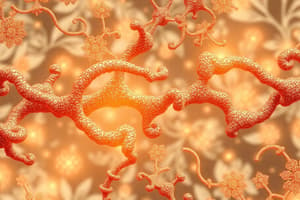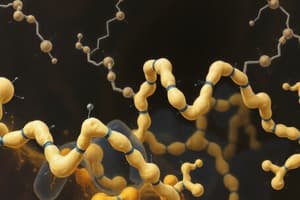Podcast
Questions and Answers
What are the structures of amino acids classified by?
What are the structures of amino acids classified by?
Their chemical properties
Which of these is an example of a protein that functions in catalysis?
Which of these is an example of a protein that functions in catalysis?
- Hemoglobin
- Myosin
- Collagen
- Enolase (correct)
How many common amino acids can be classified into five basic groups?
How many common amino acids can be classified into five basic groups?
- 5
- 15
- 20 (correct)
- 10
All amino acids are chiral.
All amino acids are chiral.
What is the significance of the L and D designation in amino acids?
What is the significance of the L and D designation in amino acids?
The two amino acids with a net negative charge at pH 7.0 are __________ and __________.
The two amino acids with a net negative charge at pH 7.0 are __________ and __________.
Which amino acid can form disulfide bonds?
Which amino acid can form disulfide bonds?
What is the primary role of hemoglobin?
What is the primary role of hemoglobin?
Match the following amino acids with their characteristics:
Match the following amino acids with their characteristics:
What unique feature do proteins contain in terms of amino acids?
What unique feature do proteins contain in terms of amino acids?
Which of the following amino acids has a hydroxyl group in its R group?
Which of the following amino acids has a hydroxyl group in its R group?
Cysteine can be oxidized to form a covalently linked dimer called __________.
Cysteine can be oxidized to form a covalently linked dimer called __________.
Flashcards are hidden until you start studying
Study Notes
Learning Outcomes
- Ability to describe structures of 20 amino acids and their three-letter nomenclature.
- Classification of amino acids based on chemical properties.
- Recognition of uncommon amino acids and their functions.
- Understanding amino acids as buffers and their titration curves.
- Explanation of peptide bond formation and amino acid polymers.
Proteins
- Serve as main agents of biological function, performing various tasks:
- Catalysis: Enzymes like enolase (glycolysis) and DNA polymerase (DNA replication).
- Transport: Hemoglobin (O2 transport in blood), lactose permease (lactose transport).
- Structure: Collagen (connective tissue), keratin (hair, nails, feathers).
- Motion: Myosin and actin (muscle contraction and motility).
Amino Acids
- Building blocks of proteins, structured as linear heteropolymers of α-amino acids.
- Share common features, differing primarily at R substituents, allowing diverse biological functions:
- Capacity to polymerize.
- Useful acid-base properties.
- Varied physical properties.
- Varied chemical functionality.
Chirality of Amino Acids
- All amino acids are chiral except glycine, which has a non-chiral α-carbon.
- α-Carbon is tetrahedral with four different substituents creating two spatial arrangements (enantiomers: L and D).
- Only L-amino acids are incorporated into proteins.
Amino Acid Classification
- Amino acids can be classified into five groups based on R substituents:
- Nonpolar, aliphatic (7 types).
- Aromatic (3 types).
- Polar, uncharged (5 types).
- Positively charged (3 types).
- Negatively charged (2 types).
Nonpolar, Aliphatic R Groups
- R groups are hydrophobic and insoluble in water.
- Key types include:
- Glycine (Gly): Achiral, minor contribution to hydrophobic interactions.
- Methionine (Met): Contains a nonpolar thioether bond.
- Proline: Features a cyclic structure; reduces flexibility in polypeptides.
Aromatic R Groups
- Absorb UV light at 270-280 nm, in the order of Trp > Tyr > Phe.
- Generally non-polar but Tyr and Trp are more polar due to:
- Hydroxyl group (OH) in Tyr.
- Nitrogen in the indole ring of Trp.
Polar, Uncharged R Groups
- Include serine, threonine (hydroxyl groups), aspartate, glutamate (amide groups), and cysteine (sulfhydryl group).
- Cysteine can form disulfide bonds, enhancing protein structure stability.
- Disulfide bonds are crucial for maintaining protein structure.
Positively Charged R Groups
- Basic amino acids with net positive charge at pH 7.0 include:
- Lysine (Lys): Contains a primary amino group.
- Arginine (Arg): Has a guanidinium group.
- Histidine (His): Contains an aromatic imidazole group.
Negatively Charged R Groups
- Acidic amino acids with a net negative charge at pH 7.0 are aspartate (Asp) and glutamate (Glu), each having an additional carboxyl group.
Uncommon Amino Acids
- Not typically incorporated by ribosomes, with exception of selenocysteine.
- Arise from post-translational modifications in proteins.
- Modifications such as phosphorylation play important roles in regulation and signaling.
Ionization of Amino Acids
- Amino and carboxyl groups act as weak acids and bases.
- At acidic pH, the carboxyl group is protonated, influencing the overall charge and behavior of amino acids.
Studying That Suits You
Use AI to generate personalized quizzes and flashcards to suit your learning preferences.




